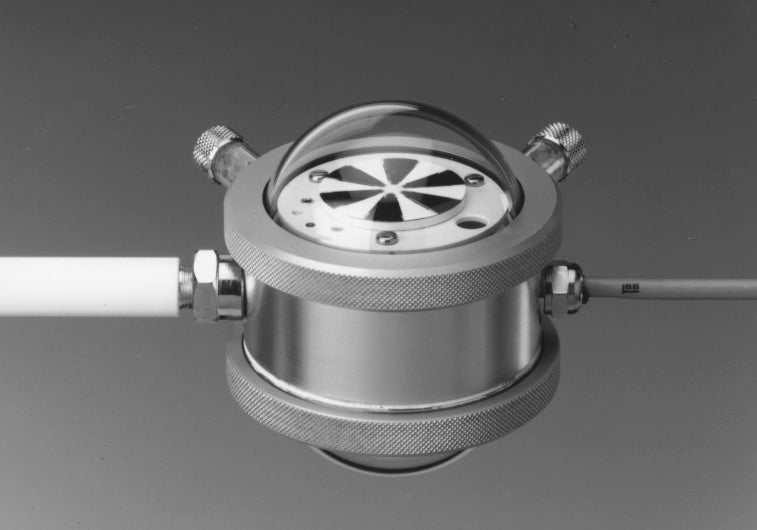Description
The double pyranometer is used to determine the reflectivity ("albedo") of the soil in percent. It also allows the calculation of the shortwave radiation balance.
Two complete star pyranometers are mounted on a connecting ring, offset by 180°, and provided with mounting elements. Two holes are provided for mounting on a base.
Measuring principle
The upward-facing star pyranometer measures the global radiation G, while the ground-facing star pyranometer measures the short-wave reflected radiation R.
Albedo A indicates the amount of reflection on a surface in percent and can be calculated as follows
be: A = (R . 100) / G
The shortwave radiation balance KS (the available shortwave radiation on a horizontal surface) is calculated
as follows: KS = G - R (Joule, Watt)
Assembly
Two holes are provided on the handle for mounting. The double pyranometer can be mounted either horizontally (using a spirit level) or parallel to a reference surface.
Color code of the outputs:
Page 1: green - white
Cable: green + (pos.), white - (neg.)
Page 2: yellow - brown
Cable: yellow + (pos.), brown - (neg.)
introduction
The double pyranometer in its current form was developed by Dirmhirn. It belongs to the "black-and-white surface pyranometer" group of meteorological radiation measuring instruments and is used to measure global radiation, sky radiation, shortwave reflected radiation, and shortwave radiation on variously oriented and inclined surfaces. Global radiation is the radiation incident from the upper hemisphere onto a horizontal surface in the wavelength range of the solar spectrum from 0.3 to 3 μm and is the sum of direct solar and diffuse sky radiation.
Pyranometers do not measure radiation intensity directly, but indirectly via a temperature difference generated by the radiation. In electrical pyranometers, this difference is converted into a proportional electromotive force using a thermocouple. In this way, the complex measurement of a radiation current is reduced to the simple measurement of an electrical voltage.
Global radiation, an important measurement parameter in environmental research, must be able to be determined under a wide range of weather conditions, so only a correspondingly robust and corrosion-resistant design of the measuring device can guarantee trouble-free operation.
Description
The radiation-sensitive surfaces of the double pyranometer consist of 12 circularly arranged copper plates, each painted black and white. When exposed to radiation, the black plates heat up more than the white ones. This temperature difference is measured using the thermopile attached to the underside of the plates. The voltage developed by this thermopile is approximately 15 μV/Wm-2 with an internal resistance of approximately 35 ohms.
To protect the receiver surfaces, a glass dome made of ground optical "SCHOTT" glass is provided, which is tightly connected to the housing by means of two sealing rings and a screw ring.
Two drying containers containing silica gel screwed onto the outside prevent condensation inside the device.
The connecting cable is routed through a waterproof screw connection, which also seals the interior from ambient air. A spirit level is provided for leveling the device.
maintenance
The glass domes of pyranometers in continuous use should, if possible, be wiped clean and dry at least once a day. Ice deposits must be removed very carefully, using de-icing spray if necessary. The setup should be checked daily if possible. The receiver surfaces must always be black and white. If irregularities or other defects appear on the receiver surfaces, an inspection at our factory is essential. Scratching of both the receiver surfaces and the glass dome must be avoided at all costs. On the side of the double pyranometer housing are screw-on drying containers filled with silica gel. This drying substance must always be red. If the substance appears pale, it must be replaced. If no new filling is available, the substance can be reactivated at a temperature of 80°C.
calibration
Pyranometers in continuous use should be calibrated at least every two years; annual calibration is recommended. The supplier will be happy to perform the calibration for you.
Options, spare parts
Glass dome (B1810107)
1 set of seals (6 pieces) (B1810402)
Silica gel container with filling (B1810403)
Double pyranometer for determining the reflectivity ("albedo") of the soil in percent. It also allows the calculation of the shortwave radiation balance.
"First class" according to WMO and ISO 9060, worldwide market leader in long-term use independent of ambient temperatures, year-round measurement possible.
The measuring principle of the double pyranometer is based on differential temperature measurement between white and black surfaces. This prevents any influence from the ambient temperature. Environmental influences are shielded from the sensor surfaces by two ground precision glass domes. Two drying chambers prevent condensation. Horizontal installation is simplified by a built-in bubble level. Each device is supplied with a calibration certificate.

